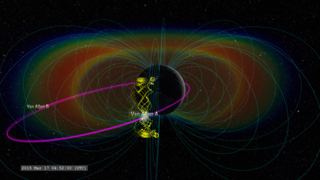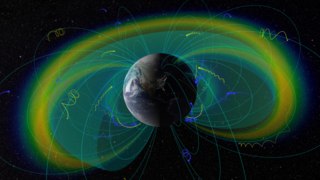Earth
Sun
ID: 4595
Near-Earth space is not empty. It is filled with energetic charged particles and magnetic fields from the Sun and Earth. Some of these energetic particles make it into Earth's upper atmosphere, where they can create auroras around the north and south magnetic poles. But most of these energetic particles stay trapped by Earth's magnetic field, forming concentric belts encircling the planet, called the Van Allen Radiation Belts (Radiation Belts & Plasmapause).
When energetic particles are injected into Earth's radiation belts, perhaps by a reconnection event in Earth's magnetotail, they can become trapped by the geomagnetic field. Consequently, these energetic particles will propagate around Earth as they slowly disperse. If a satellite with particle monitors lies along the particle trajectory, the satellite can detect these particles (Prompt Electron Acceleration in the Radiation Belts). With multiple satellite detections, it is possible to approximately reconstruct the origin and path of the original particle injection. These visualizations illustrate the results of this reconstruction applied to a series of particle injections detected by multiple satellites on April 7, 2016.
In this visualization, we distinguish each injection with a different color, and that color is used to flash the satellite detecting that particular injection. The injections drift around Earth by a process called gradient drift (Plasma Zoo: Particle Drift in a Magnetic Gradient). Negative charged particles drift eastward (corresponding to counter-clockwise in the visualization view above the north geographic pole), while positive charged particles drift westward (corresponding to clockwise in the visualization view).
Mapping Particle Injections in Earth's Magnetosphere
When energetic particles are injected into Earth's radiation belts, perhaps by a reconnection event in Earth's magnetotail, they can become trapped by the geomagnetic field. Consequently, these energetic particles will propagate around Earth as they slowly disperse. If a satellite with particle monitors lies along the particle trajectory, the satellite can detect these particles (Prompt Electron Acceleration in the Radiation Belts). With multiple satellite detections, it is possible to approximately reconstruct the origin and path of the original particle injection. These visualizations illustrate the results of this reconstruction applied to a series of particle injections detected by multiple satellites on April 7, 2016.
In this visualization, we distinguish each injection with a different color, and that color is used to flash the satellite detecting that particular injection. The injections drift around Earth by a process called gradient drift (Plasma Zoo: Particle Drift in a Magnetic Gradient). Negative charged particles drift eastward (corresponding to counter-clockwise in the visualization view above the north geographic pole), while positive charged particles drift westward (corresponding to clockwise in the visualization view).
Related
For More Information
Visualization Credits
Tom Bridgman (Global Science and Technology, Inc.): Lead Visualizer
Drew L. Turner (Space Sciences Department, The Aerospace Corporation): Lead Scientist
Mara Johnson-Groh (Wyle Information Systems): Lead Writer
Genna Duberstein (USRA): Producer
Laurence Schuler (ADNET Systems, Inc.): Technical Support
Ian Jones (ADNET Systems, Inc.): Technical Support
Drew L. Turner (Space Sciences Department, The Aerospace Corporation): Lead Scientist
Mara Johnson-Groh (Wyle Information Systems): Lead Writer
Genna Duberstein (USRA): Producer
Laurence Schuler (ADNET Systems, Inc.): Technical Support
Ian Jones (ADNET Systems, Inc.): Technical Support
Please give credit for this item to:
NASA's Scientific Visualization Studio
NASA's Scientific Visualization Studio
Short URL to share this page:
https://svs.gsfc.nasa.gov/4595
Missions:
Geotail
Magnetospheric Multiscale (MMS)
THEMIS
Van Allen Probes
Data Used:
Note: While we identify the data sets used in these visualizations, we do not store any further details nor the data sets themselves on our site.
Keywords:
SVS >> Geomagnetic Field
SVS >> Magnetosphere
SVS >> Radiation Belts
SVS >> Hyperwall
NASA Science >> Earth
NASA Science >> Sun
https://svs.gsfc.nasa.gov/4595
Missions:
Geotail
Magnetospheric Multiscale (MMS)
THEMIS
Van Allen Probes
Data Used:
SSCweb also referred to as: SSCweb ephemerides
Ephemeris - NASA/GSFC Space Physics Data Facility
Satellite ephemerides
Space-Track Two-Line Elements also referred to as: Space-Track TLE
Ephemeris - NORAD
Satellite ephemerides
Keywords:
SVS >> Geomagnetic Field
SVS >> Magnetosphere
SVS >> Radiation Belts
SVS >> Hyperwall
NASA Science >> Earth
NASA Science >> Sun














